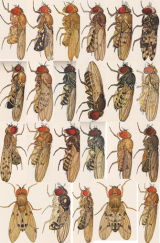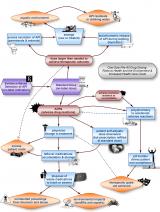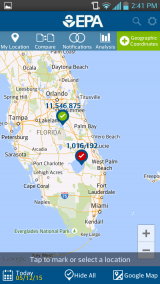Pathfinder Innovation Projects: Awardees for 2012
See below to learn more about the second year of Pathfinder Innovation Projects.
Generating a cyber infrastructure for personal air quality estimates
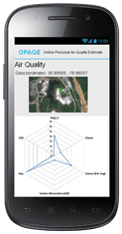 Personal air quality indicators could give people more information about their health in real time.People are exposed to air pollutants every day, and Lyle Burgoon, EPA supervisory biologist, set out to create a way to produce personal air quality estimates. When finished, the OPAQE app will collect publicly available geographic and physiology data and match that data to real-time air quality measurements found in EPA’s AirNow network. This crowdsourcing project has the potential to allow scientists to understand air pollution exposures in real-time and on a large scale.
Personal air quality indicators could give people more information about their health in real time.People are exposed to air pollutants every day, and Lyle Burgoon, EPA supervisory biologist, set out to create a way to produce personal air quality estimates. When finished, the OPAQE app will collect publicly available geographic and physiology data and match that data to real-time air quality measurements found in EPA’s AirNow network. This crowdsourcing project has the potential to allow scientists to understand air pollution exposures in real-time and on a large scale.
Using fruit flies as model organisms for rapid screening volatile chemicals for toxic effects
No screening protocols currently evaluate volatile chemicals in a fast, efficient manner. Phillip Bushnell, EPA research toxicologist, wondered if the fruit fly could serve as a useful model. Flies are inexpensive insects that offer two distinct advantages compared with existing screening tests in isolated cell cultures. First, scientists know a lot about fly genetics. Second, flies can also be exposed to vapors and other airborne materials that researchers can’t test in cells or aquatic organisms. If the proof-of-concept works, the fruit fly could allow researchers to rapidly screen volatile chemicals for their toxicity in whole animals. Scientists could then combine that data with knowledge of fly genetics to one day predict toxicity for animals and humans.
Creating more reliable risk assessments for water-borne viruses
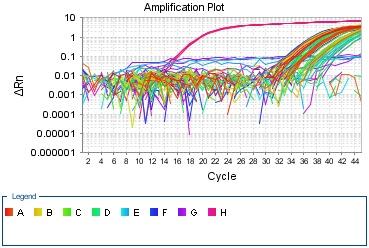 This amplification curve shows the presence of viral nucleic acids in water samples.Jennifer Cashdollar, EPA microbiologist, tackled a paradox of water testing. Cell cultures can tell scientists if viruses might be infectious, but the method is slow and can’t be applied in the field. On the other hand, rapid molecular tests that could fit in portable devices don’t distinguish between potentially infectious whole virus particles and benign nucleic acid fragments. The project aimed to determine if standard virus filtration procedures used to isolate these organisms from water would detect viral fragments. If the tests don’t concentrate the nucleic acids, the molecular signal would almost certainly originate from the potentially infectious whole particles. This idea could significantly improve the way in which EPA designs risk assessments for microbial contamination and help researchers better protect public health.
This amplification curve shows the presence of viral nucleic acids in water samples.Jennifer Cashdollar, EPA microbiologist, tackled a paradox of water testing. Cell cultures can tell scientists if viruses might be infectious, but the method is slow and can’t be applied in the field. On the other hand, rapid molecular tests that could fit in portable devices don’t distinguish between potentially infectious whole virus particles and benign nucleic acid fragments. The project aimed to determine if standard virus filtration procedures used to isolate these organisms from water would detect viral fragments. If the tests don’t concentrate the nucleic acids, the molecular signal would almost certainly originate from the potentially infectious whole particles. This idea could significantly improve the way in which EPA designs risk assessments for microbial contamination and help researchers better protect public health.
More information:
Read an EPA blog.
Read a paper published in Applied and Environmental Microbiology.
Eliminating active pharmaceutical ingredients from the environment using prescription reduction
After people use medications, the collection of leftover drugs and conventional sewage treatment have served as the primary means for controlling the amount of active pharmaceutical ingredients (APIs) in the environment. EPA research physical scientist Christian Daughton proposed “eco-directed sustainable prescribing.” This approach relies on pollution prevention and targets human excretion, a major source of APIs that enter the environment. Doctors could match medications based on how extensively a person’s body will metabolize a drug, leaving fewer APIs to excrete. Such pollution prevention tactics could spur the advancement of a sustainable healthcare system by treating the patient and the environment as an integrated whole.
More information:
Read an EPA blog.
Read another EPA blog.
Read a University of Illinois blog about the project. Exit
Read a paper published in Science of the Total Environment. Exit -- named an Editors' Choice Article
Read a blog from the American Association of Pharmaceutical Scientists. Exit
Read a blog from The Guardian. Exit
Read a second paper published in Science of the Total Environment. Exit
Evaluating the entire impact of sustainable solutions
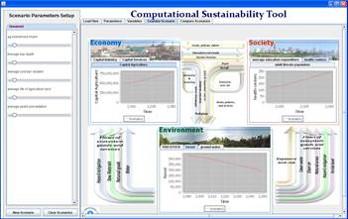 Users can choose from 200 parameters to assess the complexities of sustainability decisions. Sustainability remains a concept that can take many forms, and its realization involves the pillars of society, environment and industry. William Lefew, EPA mathematician, worked to design a scenario-based visualization tool. Specifically, the project developed a prototype that processes complicated, research-based computational models complete with the three main pillars of sustainability assessments. Stakeholders can then interpret, discuss and debate the results of the assessment relative to their own value systems. In the future, such work could help EPA more fully evaluate sustainability questions with respect to a variety of value systems.
Users can choose from 200 parameters to assess the complexities of sustainability decisions. Sustainability remains a concept that can take many forms, and its realization involves the pillars of society, environment and industry. William Lefew, EPA mathematician, worked to design a scenario-based visualization tool. Specifically, the project developed a prototype that processes complicated, research-based computational models complete with the three main pillars of sustainability assessments. Stakeholders can then interpret, discuss and debate the results of the assessment relative to their own value systems. In the future, such work could help EPA more fully evaluate sustainability questions with respect to a variety of value systems.
Pairing new algorithms with satelitte images to predict bacterial blooms in freshwater lakes and streams
Ross Lunetta, EPA research physical scientist, assessed and validated a new algorithm that analyzed satellite images of cyanobacteria bloom development and dissipation. Cyanobacteria can cause human illness, including respiratory irritation, and make potable water taste bad or smell. The research has the potential to serve as the groundwork for improved indicators than will result in more precise ecological and public human health advisories. Additionally, the project used open challenges and innovation prizes to build and begin testing an algorithm that could predict cyanobacteria blooms.
More information:
Read an EPA blog.
Read a paper published in Remote Sensing of Environment. Exit
Tracking genetic barcodes to assess ecosystem health
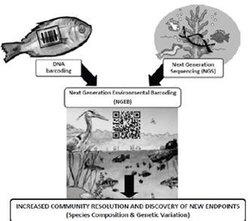 Next-generation environmental barcoding will allow scientists to use robust biodiversity measures and consider genetic variation among species to improve environmental assessments.Carolina Penalva-Arana, EPA molecular biologist, took advantage of the genetic fingerprints every species has and used those identifiers to assess ecosystem health. The project used a technique called “next-generation environmental barcoding.” With this method, scientists can process water samples to reveal which groups of species are present. Taken a step further, the technique might help identify environmental stressors based on the presence or absence of key species. Applying this type of sequencing at a large scale could translate to more robust evaluations of ecosystem health and sustainability.
Next-generation environmental barcoding will allow scientists to use robust biodiversity measures and consider genetic variation among species to improve environmental assessments.Carolina Penalva-Arana, EPA molecular biologist, took advantage of the genetic fingerprints every species has and used those identifiers to assess ecosystem health. The project used a technique called “next-generation environmental barcoding.” With this method, scientists can process water samples to reveal which groups of species are present. Taken a step further, the technique might help identify environmental stressors based on the presence or absence of key species. Applying this type of sequencing at a large scale could translate to more robust evaluations of ecosystem health and sustainability.
More information:
Read an EPA interview.
Transforming our treatment technologies to produce freshwater
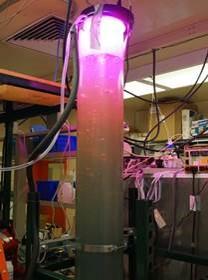 A photobioreactor helps researchers grow and harvest algae that absorb salt from water as they mature.One percent of the world’s water is accessible for human drinking. Clean freshwater remains a precious commodity, a problem that E. Sahle-Demessie, EPA chemical engineer, explored. The project tested a biological method for removing salt from seawater: algae. The algae absorb salt and store it as they grow. Researchers can then filter the water to capture, dehydrate and extract lipids from mature algae to produce biofuel. If successful, this research would serve as the starting point for a major shift in freshwater resources with an added bonus of exploring new sources of bio-energy.
A photobioreactor helps researchers grow and harvest algae that absorb salt from water as they mature.One percent of the world’s water is accessible for human drinking. Clean freshwater remains a precious commodity, a problem that E. Sahle-Demessie, EPA chemical engineer, explored. The project tested a biological method for removing salt from seawater: algae. The algae absorb salt and store it as they grow. Researchers can then filter the water to capture, dehydrate and extract lipids from mature algae to produce biofuel. If successful, this research would serve as the starting point for a major shift in freshwater resources with an added bonus of exploring new sources of bio-energy.
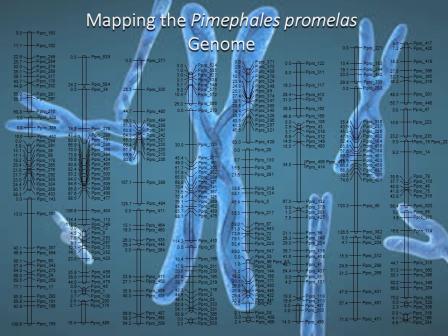 Mapping the genome of the fathead minnow will help enhance research capabilities for this organism that is key for many aquatic toxicology studies.
Mapping the genome of the fathead minnow will help enhance research capabilities for this organism that is key for many aquatic toxicology studies.
Incorporating genetic susceptibility into species risk assessments
EPA environmental geneticist Eric Waits knew that scientists lacked a complete genomic picture of the fathead minnow, a popular model organism used for many types of chemical screenings. He sifted and sorted fathead minnow DNA fragments to find overlapping patches and then stitched together the larger chromosomes. Once researchers have a good map of the genome, they can begin to understand the intersection of environmental forces and gene-level changes. This will help connect individual responses, positive and negative, to broader, population-scale trends.
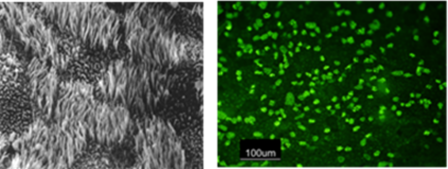 Primary human bronchial cells with cilia (L) and goblet cells (R) that were grown at the air-liquid interface are similar to lung epithelial cells in the body. Building an exposure system that mimics human lungs to improve air pollutant testing
Primary human bronchial cells with cilia (L) and goblet cells (R) that were grown at the air-liquid interface are similar to lung epithelial cells in the body. Building an exposure system that mimics human lungs to improve air pollutant testing
A traditional method for testing toxic effects of aerosols and gases uses cells submerged in culture medium. But our lungs operate in a much more dynamic environment. Amy Wang, EPA biologist, used culture conditions that simulated the complexity of lungs, an environment where only a thin liquid layer separates cells from air. Moreover, the project involved inventing a system to simultaneously control aerosol mixtures in multiple-well plates. After validation, these improvements will let scientists screen more chemicals – from particles and aerosols to vapors and volatiles – in less time.
More information:
Read an EPA blog.

